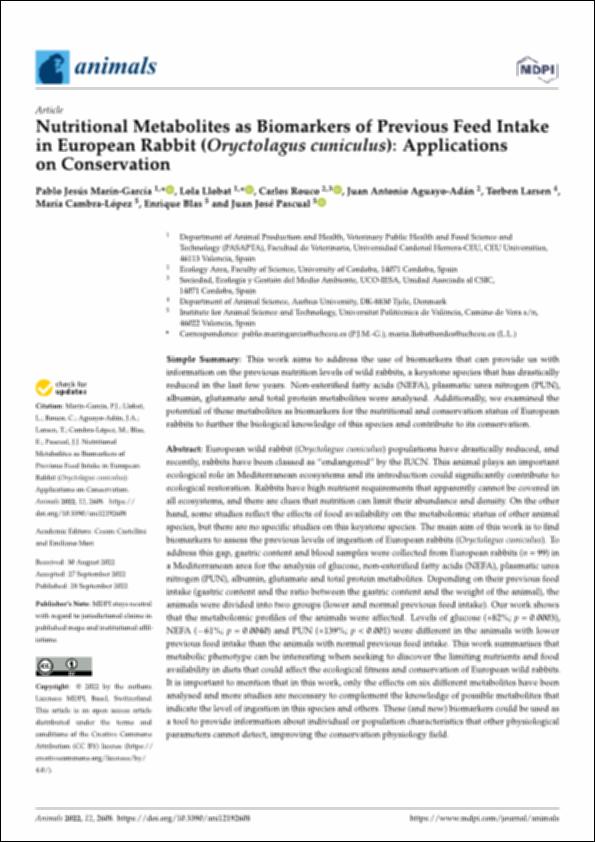Por favor, use este identificador para citar o enlazar este ítem:
http://hdl.handle.net/10637/14187Nutritional metabolites as biomarkers of previous feed intake in European rabbit (Oryctolagus cuniculus) applications on conservation
| Título : | Nutritional metabolites as biomarkers of previous feed intake in European rabbit (Oryctolagus cuniculus) applications on conservation |
| Autor : | Marín García, Pablo Jesús Llobat Bordes, Lola Rouco Zufiaurre, Carlos Aguayo Adán, Juan Antonio Larsen, Torben Cambra López, María Blas Ferrer, Enrique Pascual Amorós, Juan José |
| Materias: | Conejos - Protección.; Conejos - Alimentación - Aspectos bioquímicos.; Rabbits - Feeding and feeds - Biochemical aspects.; Rabbits - Protection. |
| Editorial : | MDPI |
| Citación : | Marín-García, P. J., Llobat, L., Rouco, C., Aguayo-Adán, J. A., Larsen, T., Cambra-López, M., Blas, E. & Pascual, J. J. (2022). Nutritional metabolites as biomarkers of previous feed intake in european rabbit (Oryctolagus cuniculus): applications on conservation. Animals, vol. 12, i.19 (28 sep.), art. 2608. DOI: https://doi.org/10.3390/ani12192608 |
| Resumen : | European wild rabbit (Oryctolagus cuniculus) populations have drastically reduced, and recently, rabbits have been classed as “endangered” by the IUCN. This animal plays an important ecological role in Mediterranean ecosystems and its introduction could significantly contribute to ecological restoration. Rabbits have high nutrient requirements that apparently cannot be covered in all ecosystems, and there are clues that nutrition can limit their abundance and density. On the other hand, some studies reflect the effects of food availability on the metabolomic status of other animal species, but there are no specific studies on this keystone species. The main aim of this work is to find biomarkers to assess the previous levels of ingestion of European rabbits (Oryctolagus cuniculus). To address this gap, gastric content and blood samples were collected from European rabbits (n = 99) in a Mediterranean area for the analysis of glucose, non-esterified fatty acids (NEFA), plasmatic urea nitrogen (PUN), albumin, glutamate and total protein metabolites. Depending on their previous feed intake (gastric content and the ratio between the gastric content and the weight of the animal), the animals were divided into two groups (lower and normal previous feed intake). Our work shows that the metabolomic profiles of the animals were affected. Levels of glucose (+82%; p = 0.0003), NEFA (61%; p = 0.0040) and PUN (+139%; p < 0.001) were different in the animals with lower previous feed intake than the animals with normal previous feed intake. This work summarises that metabolic phenotype can be interesting when seeking to discover the limiting nutrients and food availability in diets that could affect the ecological fitness and conservation of European wild rabbits. It is important to mention that in this work, only the effects on six different metabolites have been analysed and more studies are necessary to complement the knowledge of possible metabolites that indicate the level of ingestion in this species and others. These (and new) biomarkers could be used as a tool to provide information about individual or population characteristics that other physiological parameters cannot detect, improving the conservation physiology field. |
| Descripción : | Este artículo se encuentra disponible en la siguiente URL: https://www.mdpi.com/2076-2615/12/19/2608 Este artículo pertenece a la colección "Human-Wildlife Conflict and Interaction". |
| URI : | http://hdl.handle.net/10637/14187 |
| Derechos: | http://creativecommons.org/licenses/by/4.0/deed.es |
| ISSN : | 2076-2615 (Electrónico) |
| Idioma: | es |
| Fecha de publicación : | 28-sep-2022 |
| Centro : | Universidad Cardenal Herrera-CEU |
| Aparece en las colecciones: | Dpto. Producción y Sanidad Animal, Salud Pública Veterinaria y Ciencia y Tecnología de los Alimentos |
Los ítems de DSpace están protegidos por copyright, con todos los derechos reservados, a menos que se indique lo contrario.


